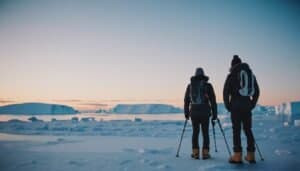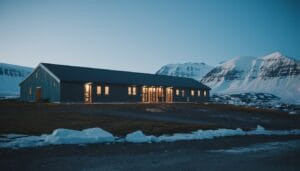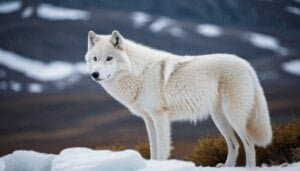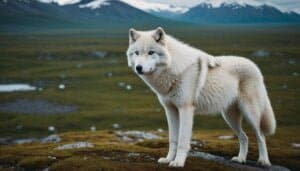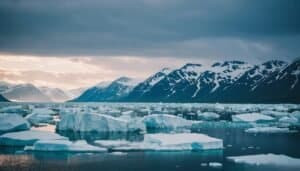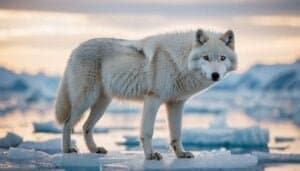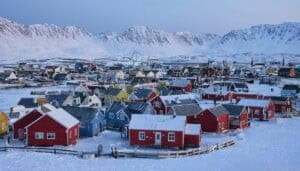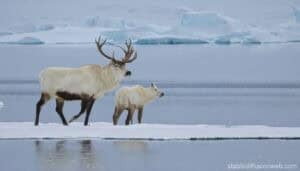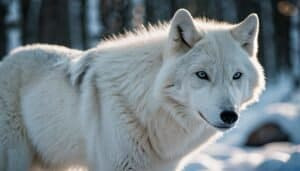Introduction
Arctic wolves have become emblematic figures in modern wildlife documentaries, captivating audiences with their resilience and enigmatic behavior. As apex predators in the Arctic tundra, these wolves play a critical role in depicting the delicate balance of the Arctic ecosystem
Through stunning visuals and powerful narratives, wildlife documentaries showcase their lives, raising awareness about conservation and the impacts of climate change
This article delves into the reasons behind the popularity of Arctic wolves in documentaries, the challenges filmmakers face, and the significant messages conveyed through these films
The Role of Arctic Wolves in Wildlife Documentaries
Arctic wolves have emerged as one of the most captivating subjects in wildlife documentaries, offering viewers a rare glimpse into life in some of the most inhospitable environments on Earth
Their unique adaptability to extreme Arctic conditions and their intriguing social structures make them an ideal focal point for storytelling
Documentaries featuring Arctic wolves not only provide educational insights but also inspire efforts to protect these resilient creatures and their fragile habitats
Why Arctic Wolves Are Popular Subjects in Documentaries
Arctic wolves are a favored subject in wildlife documentaries due to their mystique and symbolic representation of untamed wilderness. Their snow-white fur blends seamlessly with the Arctic landscape, creating visually stunning imagery that appeals to audiences worldwide
Furthermore, their rarity—living exclusively in remote, uninhabitable regions—adds an element of intrigue. Documentaries like National Geographic’s Arctic Wolf Pack (2016) highlight their tight-knit pack dynamics and survival strategies, fostering admiration and curiosity about these elusive predators
Another reason for their popularity is their role in the Arctic ecosystem. As apex predators, Arctic wolves regulate prey populations, ensuring ecological balance. Documentaries utilize this predatory role to illustrate the interconnectedness of Arctic species, from musk oxen to Arctic hares
Through breathtaking cinematography and compelling narratives, filmmakers portray Arctic wolves as symbols of survival and adaptation, resonating deeply with viewers
Showcasing Arctic Wolves’ Behavior and Ecosystem
Wildlife documentaries delve into the behaviors of Arctic wolves to unveil the intricacies of their lives. Filmmakers document key behaviors such as hunting techniques, pack communication, and denning habits
For example, BBC’s Frozen Planet II (2022) features sequences of Arctic wolves tracking prey across vast ice fields, emphasizing their endurance and teamwork
The ecosystem surrounding these wolves also becomes a narrative focus. Documentaries highlight how their predatory habits sustain the Arctic food web, preventing overpopulation of herbivores like caribou
Additionally, by depicting their seasonal migrations, filmmakers illustrate the broader challenges of life in the Arctic, including changing prey availability and shifting ice patterns caused by climate change
These portrayals inform and engage audiences, fostering a deeper appreciation for the Arctic’s delicate ecology
How Wildlife Films Influence Conservation Efforts
The impact of wildlife documentaries extends beyond entertainment. Films featuring Arctic wolves have played a significant role in promoting conservation. By presenting the wolves as charismatic yet vulnerable, documentaries spark emotional connections that drive advocacy for Arctic preservation
For instance, campaigns following the release of major films like Planet Earth (2006) have raised significant funds for conservation programs aimed at mitigating the effects of climate change on Arctic habitats
Moreover, documentaries often collaborate with conservation organizations to amplify their message. Productions by institutions like WWF and National Geographic use Arctic wolves to symbolize the urgency of climate action
By showcasing their struggle against environmental threats, such as shrinking ice caps and declining prey populations, these films inspire viewers to support sustainability efforts, emphasizing that saving Arctic wolves also means protecting the broader Arctic ecosystem
Challenges of Filming Arctic Wolves
Documenting Arctic wolves in their natural habitat is no small feat. The remote and extreme conditions of the Arctic tundra present numerous obstacles for filmmakers, requiring advanced preparation and innovative techniques
Despite these challenges, the rewards of capturing the lives of these elusive creatures on film are unparalleled, providing invaluable insights into their behavior and the ecosystem they inhabit
Overcoming Arctic Climate Challenges
The Arctic tundra’s extreme environment is one of the greatest hurdles filmmakers face when capturing footage of Arctic wolves. With temperatures plummeting as low as -40°F and constant exposure to icy winds, maintaining equipment and crew health is a monumental task
Specialized gear, such as cameras with insulated housings and drones capable of withstanding freezing temperatures, is essential for enduring such conditions
Seasonal weather also complicates filming. During the Arctic winter, near-constant darkness limits visibility, while the summer brings challenges like melting ice and unpredictable storms
Despite these difficulties, documentaries like Arctic Wolves: Ghosts of the Tundra (2020) showcase the beauty of this rugged environment, emphasizing the resilience of the wolves and the determination of filmmakers
Technological Advances in Capturing Wolves
Technological innovations have significantly enhanced filmmakers’ ability to document Arctic wolves. High-resolution drones, for example, enable crews to observe wolves from a distance without disturbing their natural behaviors
Thermal imaging cameras provide insights into nocturnal activities, revealing hunting and social interactions that were previously impossible to capture
Time-lapse photography is another game-changer, used to depict seasonal changes in the Arctic landscape and how wolves adapt
One notable example is the use of motion-sensor cameras placed near dens to unobtrusively film pups as they grow and interact within the pack. These advancements not only improve the quality of the footage but also provide scientists with valuable data on Arctic wolf ecology
Ethical Considerations in Wildlife Filmmaking
Filming Arctic wolves raises ethical questions about human intervention in the wild. Maintaining the wolves’ natural behavior is a primary concern, as close proximity or excessive drone use could stress the animals or alter their habits
Wildlife filmmakers must adhere to strict ethical guidelines, such as those outlined by the International Association of Wildlife Filmmakers, to minimize their impact on the wolves and the ecosystem
Additionally, portraying Arctic wolves accurately and without anthropomorphism is crucial. Some documentaries risk oversimplifying their behavior to fit dramatic narratives, which can mislead audiences. Responsible filmmakers aim to balance storytelling with factual representation, ensuring that viewers gain an authentic understanding of the species
Through meticulous planning, innovative technology, and ethical practices, wildlife filmmakers overcome the challenges of the Arctic to create compelling documentaries that showcase the enigmatic lives of Arctic wolves
Arctic Wolves and Climate Change in Documentaries
Arctic wolves are increasingly featured in wildlife documentaries as powerful symbols of the Arctic’s vulnerability to climate change
By highlighting the wolves’ struggles to adapt to a rapidly shifting environment, filmmakers aim to raise awareness about the broader ecological impacts of global warming. These narratives not only inform audiences but also inspire action to protect this fragile region and its iconic inhabitants
Highlighting Environmental Impacts Through Wolves
Documentaries use Arctic wolves as a lens to explore the far-reaching effects of climate change on the Arctic ecosystem
Shrinking ice coverage, thawing permafrost, and shifting prey populations directly impact these predators, offering a clear example of how environmental changes disrupt food chains. For instance, wolves’ traditional prey, such as caribou and musk oxen, may migrate to new areas or decline in numbers, forcing wolves to travel greater distances in search of food
Films like Frozen Worlds (2021) depict the wolves’ challenges in securing sustenance during harsh winters, underscoring the interconnectedness of climate change and survival. By showcasing these struggles, documentaries emphasize the urgency of addressing climate issues not only for Arctic wolves but for the entire ecosystem
Wolves as Ambassadors of Arctic Ecosystems
Arctic wolves serve as ambassadors for the Arctic’s ecological complexity. As apex predators, their survival is intertwined with the health of their environment
Documentaries highlight this relationship, showing how wolves maintain balance by regulating prey populations, which in turn influences vegetation growth and habitat structure
By focusing on the wolves’ role in the ecosystem, films create a compelling narrative that humanizes the impact of environmental changes. For instance, the loss of sea ice or increased human encroachment is shown through the lens of how it disrupts the wolves’ natural behaviors
This storytelling approach fosters empathy and a deeper understanding of the interconnected threats facing Arctic biodiversity
Documentaries Raising Awareness of Arctic Conservation
The presence of Arctic wolves in documentaries has proven effective in mobilizing conservation efforts. By presenting these animals as both majestic and vulnerable, filmmakers tap into the emotional response of audiences, motivating them to support conservation initiatives
For example, campaigns associated with major documentaries, such as Our Planet (2019), have driven funding for Arctic research and preservation projects. Additionally, these films educate viewers about specific conservation strategies, such as habitat preservation, sustainable tourism, and climate policy advocacy
Partnerships with organizations like the Arctic Council and WWF amplify these messages, turning documentaries into tools for global awareness and action. Arctic wolves become symbols of hope, resilience, and the importance of safeguarding the planet’s most vulnerable regions
Conclusion
Arctic wolves have become central figures in wildlife documentaries, captivating audiences with their resilience and highlighting the fragility of the Arctic ecosystem. Through stunning visuals and compelling narratives, these films illuminate the wolves’ behavior, the challenges they face, and their integral role in maintaining ecological balance
Despite the harsh conditions of the Arctic, advancements in technology and ethical filmmaking practices have allowed filmmakers to document their lives with unparalleled depth and accuracy
Moreover, documentaries effectively use Arctic wolves as ambassadors to raise awareness about the dire effects of climate change and the urgent need for conservation efforts. By connecting viewers emotionally to these majestic predators, these films inspire action to protect the Arctic and its inhabitants for generations to come



